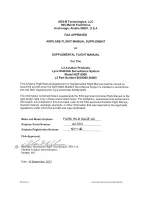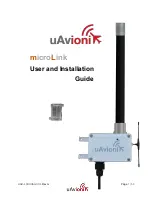
82002-PG-F
ST3400 TAWS/RMI PILOT’S GUIDE
PAGE 18
CLASS B TAWS FUNCTIONAL REQUIREMENTS
Mode Function
FLTA
Forward Looking Terrain Avoidance
PDA Premature
Descent
Alert
GPWS Mode 1
Excessive Rate of Descent
GPWS Mode 3
Altitude Loss After Takeoff
GPWS Mode 6
Voice callout “Five Hundred” when the aircraft descends
to 500 feet above the nearest runway elevation
When configured as a Class B TAWS system, the ST3400 exceeds the FAA
Class B TAWS requirements. Even in Class B mode without radar altimeter, the
ST3400 includes Class A features such as a terrain display and an excessive
glide slope deviation alert, when so installed and configured.
TAWS Required Equipment
The ST3400 uses the following equipment to meet TAWS Class A and
Class B requirements.
ST3400 TAWS EQUIPMENT REQUIREMENTS
Equipment Class
A
Class
B
Terrain Display
Integrated
Integrated
Radar Altimeter
Required
Optional
GPS or FMS System
Required
Required
Heading System
Required
Required
Audio Panel
Required
Required
Air Data Computer
Required
Required if GPS
altitude is not
available
Remote Annunciators
Optional in single pilot aircraft:
required in two-crew aircraft
Optional
Flap Position
Required
Required only if fixed-
gear or installed with
radar altimeter
Gear Position
Required
Recommended
ILS Receiver
Required
Recommended
NAV
Optional (for RMI)
Optional (for RMI)
ADF
Optional (for RMI)
Optional (for RMI)
82002-PG-F
ST3400 TAWS/RMI PILOT’S GUIDE
PAGE 19
What aircraft are required to install TAWS equipment
The FAA has mandated that all U.S. registered turbine powered aircraft
that have six or more passenger seats be equipped with a TAWS no later
than March 29, 2005.
Depending on the number of seats and the type of operation, the TAWS
requirement will be for a Class A system or a Class B system.
FAA TAWS REQUIREMENT BY TYPE OF OPERATION
Class
Type of Operation
Number of Passenger Seats
Class A
FAR Part 121
ALL
Class A
FAR Part 135
10 or more
Class B
FAR Part 135
6-9
Class B
FAR Part 91
6 or more
Why are there two different classes of TAWS
The Class B TAWS system was intended to allow smaller aircraft to meet
the TAWS minimum safety requirements at a lower cost, by eliminating
the requirements for a terrain display, radar altimeter, and airdata.
An ST3400 Class B TAWS system exceeds FAA Class B TAWS
requirements. Some ST3400 Class B models may include all Class A
features when so installed.
The ST3400 RMI Function
The ST3400 RMI function is provided to allow the ST3400 function as the
primary RMI by replacing an existing installed electromechanical RMI.
The Sandel RMI displays aircraft heading information on a calibrated
compass card read against a fixed lubber line.
Bearing is provided to both a primary pointer and a secondary pointer,
each of which is read against the compass card.
Each pointer may be switched independently to any installed navigation
source, which may be a VOR, ADF, or the GPS/FMS waypoint. The
ability to assign the GPS/FMS to a bearing pointer is unique to the ST3400
RMI.
If the navigation source has an invalid state available, the associated
bearing pointer will be removed completely from the display instead of
being parked at 90° as is common in mechanical RMIs.







































